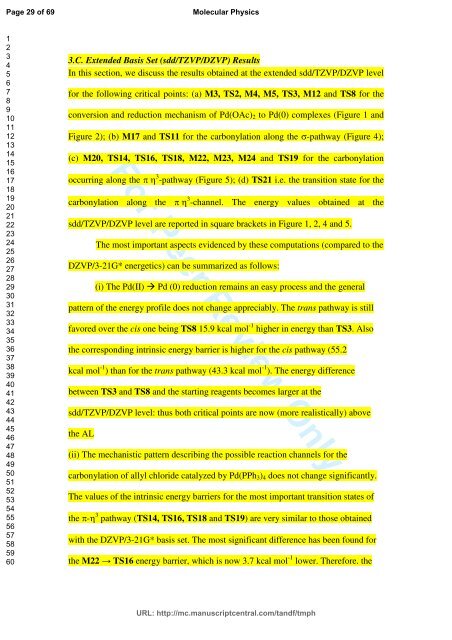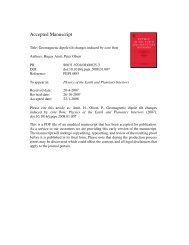For Peer Review Only - TARA
For Peer Review Only - TARA
For Peer Review Only - TARA
Create successful ePaper yourself
Turn your PDF publications into a flip-book with our unique Google optimized e-Paper software.
Page 29 of 69<br />
Molecular Physics<br />
1<br />
2<br />
3<br />
4<br />
5<br />
6<br />
7<br />
8<br />
9<br />
10<br />
11<br />
12<br />
13<br />
14<br />
15<br />
16<br />
17<br />
18<br />
19<br />
20<br />
21<br />
22<br />
23<br />
24<br />
25<br />
26<br />
27<br />
28<br />
29<br />
30<br />
31<br />
32<br />
33<br />
34<br />
35<br />
36<br />
37<br />
38<br />
39<br />
40<br />
41<br />
42<br />
43<br />
44<br />
45<br />
46<br />
47<br />
48<br />
49<br />
50<br />
51<br />
52<br />
53<br />
54<br />
55<br />
56<br />
57<br />
58<br />
59<br />
60<br />
3.C. Extended Basis Set (sdd/TZVP/DZVP) Results<br />
In this section, we discuss the results obtained at the extended sdd/TZVP/DZVP level<br />
for the following critical points: (a) M3, TS2, M4, M5, TS3, M12 and TS8 for the<br />
conversion and reduction mechanism of Pd(OAc) 2 to Pd(0) complexes (Figure 1 and<br />
Figure 2); (b) M17 and TS11 for the carbonylation along the σ-pathway (Figure 4);<br />
<strong>For</strong> <strong>Peer</strong> <strong>Review</strong> <strong>Only</strong><br />
(c) M20, TS14, TS16, TS18, M22, M23, M24 and TS19 for the carbonylation<br />
occurring along the π η 3 -pathway (Figure 5); (d) TS21 i.e. the transition state for the<br />
carbonylation along the π η 3 -channel. The energy values obtained at the<br />
sdd/TZVP/DZVP level are reported in square brackets in Figure 1, 2, 4 and 5.<br />
The most important aspects evidenced by these computations (compared to the<br />
DZVP/3-21G* energetics) can be summarized as follows:<br />
(i) The Pd(II) Pd (0) reduction remains an easy process and the general<br />
pattern of the energy profile does not change appreciably. The trans pathway is still<br />
favored over the cis one being TS8 15.9 kcal mol -1 higher in energy than TS3. Also<br />
the corresponding intrinsic energy barrier is higher for the cis pathway (55.2<br />
kcal mol -1 ) than for the trans pathway (43.3 kcal mol -1 ). The energy difference<br />
between TS3 and TS8 and the starting reagents becomes larger at the<br />
sdd/TZVP/DZVP level: thus both critical points are now (more realistically) above<br />
the AL<br />
(ii) The mechanistic pattern describing the possible reaction channels for the<br />
carbonylation of allyl chloride catalyzed by Pd(PPh 3 ) 4 does not change significantly.<br />
The values of the intrinsic energy barriers for the most important transition states of<br />
the π-η 3 pathway (TS14, TS16, TS18 and TS19) are very similar to those obtained<br />
with the DZVP/3-21G* basis set. The most significant difference has been found for<br />
the M22 → TS16 energy barrier, which is now 3.7 kcal mol -1 lower. Therefore. the<br />
URL: http://mc.manuscriptcentral.com/tandf/tmph
















